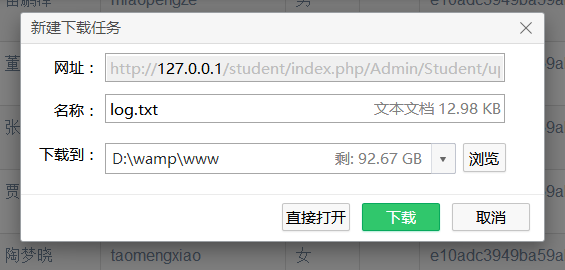ThinkPHP匯入檔案並上傳與檔案下載
阿新 • • 發佈:2019-01-07
在做網站專案時必不可少就是匯入檔案將資料傳進資料表中,並將插入資料寫入日誌檔案並下載。下面是我的程式碼與心得。
第一步:給表單中的input新增一個name屬性為file,action設定為當前控制器下的upload方法,特別注意:一定要在表單中寫入enctype="multipart/form-data
<form role="form" method="post" action="__URL__/upload" enctype="multipart/form-data"> <div class="modal-body"> <div class="form-group"> <input type="file" id="inputfile" name="file"> </div> </div> <div class="modal-footer"> <button type="button" class="btn btn-default" data-dismiss="modal">關閉</button> <button type="submit" class="btn btn-primary">匯入</button> </div> </form>
第二步:在當前控制器下新建upload方法,先判斷是否為post方式提交,如果不是則退出;設定上傳檔案的屬性如大小、字尾、根目錄等,呼叫Think模組的Upload方法,上傳檔案,失敗則提示。最後呼叫import方法,並將檔案路徑作為引數傳遞過去。
public function upload(){ if(IS_GET){ $this->display(); exit; } $upload = new \Think\Upload();//例項化上傳類 $upload->maxSize = 0 ;//設定附件上傳大小 $upload->exts = array('csv');//設定附件上傳型別 $upload->rootPath = './Public/Upload/'; //設定附件上傳根目錄 $upload->savePath = '';//設定附件上傳(子)目錄 // 上傳檔案 $info = $upload->upload(); if(!$info) {//上傳錯誤提示錯誤資訊 $this->error($upload->getError()); }else{//上傳成功 // $this->success('上傳成功!' . $info['file']['savepath'] . $info['file']['savename']); $file = './Public/upload/' . $info['file']['savepath'] . $info['file']['savename'];//檔案的完整路徑 $this->import($file);//呼叫import方法 } }
第三步:先檢測檔案編碼是否為utf8格式(檢測編碼格式的函式將在下文展示),因為學號為主鍵不能重複,所以要檢測匯入檔案中的學號是否已經存在,要將資料表中的學號提出來放到一個數組中,再將檔案裡的學號插入到陣列中,無論是否存在都將資訊寫入到日誌檔案中,並下載。
第五步:先定義要下載的檔名稱和存放目錄,使用file_exists()函式檢測檔案是否存在,使用header設定各種屬性用來顯示都愛瀏覽器中即可完成public function import($file){ //檢測檔案編碼 $encoding=detect_encoding($file); //如果不是utf8格式,則轉化為utf8 if($encoding !='UTF-8'){ $contents=file_get_contents($file); $contents=mb_convert_encoding($contents, 'utf-8',$encoding); file_put_contents($file, $contents); } $fp=fopen($file,'r'); if($fp){ $fields=array('no','name','sex'); $model=M('student'); $arrno=$model->getField('no',true); // dump($arrno); // exit; $arr=array(); $file = 'log.txt'; $file = fopen($file, 'w'); while(($row=fgetcsv($fp,1000,","))!==false){ $row=array_combine($fields, $row); if(in_array($row['no'],$arrno)){ $content = $row['no'] . "已存在" . PHP_EOL; }else{ $arrno[] = $row['no']; $name = $row['name']; $py = SpGetPinyin($name); $row['py'] = $py; $password = '123456'; $row['password'] = md5($password); $create_time = intval(time()); $row['create_time'] = $create_time; $arr[] = $row; $content = $row['no'] . "匯入成功" .PHP_EOL; } fwrite($file, $content); // dump($row); if(count($arr) == 1000){ $model->addAll($arr); unset($arr); } } fclose($file); if(count($arr)>0){ $model->addAll($arr); } // $this->success('新增成功'); $this->download(); } }
// 檔案下載
protected function download(){
$file_name = "log.txt"; //下載檔名
$file_dir = ROOT . "/"; //下載檔案存放目錄
echo $file_dir . $file_name;
//檢查檔案是否存在
if (! file_exists ( $file_dir . $file_name )) {
echo "檔案找不到";
exit ();
} else {
//開啟檔案
$file = fopen ( $file_dir . $file_name, "r" );
//輸入檔案標籤
Header ( "Content-type: application/octet-stream" );
Header ( "Accept-Ranges: bytes" );
Header ( "Accept-Length: " . filesize ( $file_dir . $file_name ) );
Header ( "Content-Disposition: attachment; filename=" . $file_name );
//輸出檔案內容
//讀取檔案內容並直接輸出到瀏覽器
echo fread ( $file, filesize ( $file_dir . $file_name ) );
fclose ( $file );
exit ();
}
}效果:

